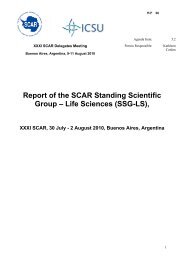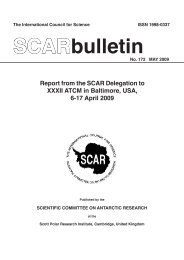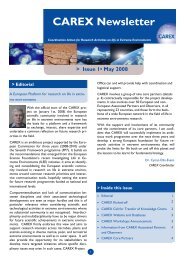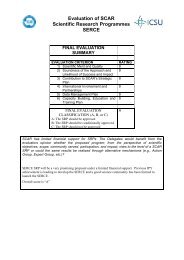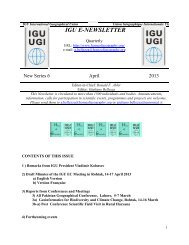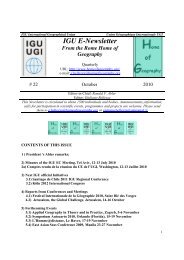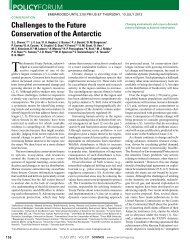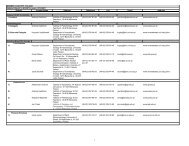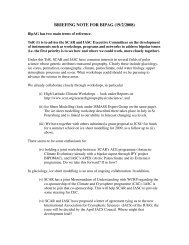Russia 2006-07 - Scientific Committee on Antarctic Research
Russia 2006-07 - Scientific Committee on Antarctic Research
Russia 2006-07 - Scientific Committee on Antarctic Research
You also want an ePaper? Increase the reach of your titles
YUMPU automatically turns print PDFs into web optimized ePapers that Google loves.
MEMBER COUNTRY: <str<strong>on</strong>g>Russia</str<strong>on</strong>g><br />
Nati<strong>on</strong>al Report to SCAR for year: <str<strong>on</strong>g>2006</str<strong>on</strong>g> - 20<str<strong>on</strong>g>07</str<strong>on</strong>g><br />
Activity C<strong>on</strong>tact Name Address Teleph<strong>on</strong>e Fax Email web site<br />
Nati<strong>on</strong>al SCAR <str<strong>on</strong>g>Committee</str<strong>on</strong>g><br />
SCAR Delegates<br />
1) Delegate V.M.Kotlyakov<br />
<str<strong>on</strong>g>Russia</str<strong>on</strong>g>n Nati<strong>on</strong>al <str<strong>on</strong>g>Committee</str<strong>on</strong>g><br />
<strong>on</strong> <strong>Antarctic</strong> <strong>Research</strong><br />
Institute of Geography,<br />
Starom<strong>on</strong>etny per.29,<br />
109017 Moskow, <str<strong>on</strong>g>Russia</str<strong>on</strong>g> 74,959,590,032 74,959,590,033 igras@igras.gl<strong>on</strong>et.ru<br />
2) Alternate Delegate M.Yu.Moskalev-sky<br />
Standing <str<strong>on</strong>g>Scientific</str<strong>on</strong>g> Groups<br />
<str<strong>on</strong>g>Russia</str<strong>on</strong>g>n Nati<strong>on</strong>al <str<strong>on</strong>g>Committee</str<strong>on</strong>g><br />
<strong>on</strong> <strong>Antarctic</strong> <strong>Research</strong><br />
Institute of Geography,<br />
Starom<strong>on</strong>etny per.29,<br />
109017 Moskow, <str<strong>on</strong>g>Russia</str<strong>on</strong>g> 74,959,590,032 74,959,590,033 moskalevsky@mail.ru<br />
Life Sciences<br />
Delegate<br />
Geosciences<br />
Delegate<br />
Physical Sciences<br />
Delegate<br />
Igor Melnikov<br />
German<br />
Leitchenkov<br />
Aleksander<br />
Klepikov<br />
Institute of Oceanology,<br />
<str<strong>on</strong>g>Russia</str<strong>on</strong>g>n Academy of<br />
Sciences,<br />
Nakhimovsky prosp.36,<br />
117852 Moscow, <str<strong>on</strong>g>Russia</str<strong>on</strong>g> 74951292018 74951245983 migor@<strong>on</strong>line.ru www.paiceh.ru<br />
VNIIOkeangeologia,<br />
Angliysky Ave, 1,<br />
190121 St.Petersburg,<br />
<str<strong>on</strong>g>Russia</str<strong>on</strong>g> 78123123551 78127141470 german_l@mail.ru<br />
Arctic and <strong>Antarctic</strong><br />
<strong>Research</strong> Institute<br />
Ul.Beringa, 38,<br />
199226 St.Petersburg,<br />
<str<strong>on</strong>g>Russia</str<strong>on</strong>g> 78123520226<br />
78123522827<br />
78123522688 klep@aari.nw.ru www.aari.aq<br />
1
Activity C<strong>on</strong>tact Name Address Teleph<strong>on</strong>e Fax Email web site<br />
<str<strong>on</strong>g>Scientific</str<strong>on</strong>g> <strong>Research</strong> Program<br />
N<strong>on</strong>e<br />
ACE<br />
1)<br />
AGCS<br />
Delegate<br />
Aleksander<br />
Klepikov<br />
2) Victor Lagun<br />
Arctic and <strong>Antarctic</strong><br />
<strong>Research</strong> Institute<br />
Ul.Beringa, 38,<br />
199226 St.Petersburg,<br />
<str<strong>on</strong>g>Russia</str<strong>on</strong>g> 78123520226 78123522688 klep@aari.nw.ru www.aari.ru<br />
Arctic and <strong>Antarctic</strong><br />
<strong>Research</strong> Institute<br />
Ul.Beringa, 38,<br />
199226 St.Petersburg,<br />
<str<strong>on</strong>g>Russia</str<strong>on</strong>g> 78123522950 78123522688 lagun@aari.nw.ru www.aari.aq<br />
N<strong>on</strong>e<br />
EBA<br />
Delegate<br />
ICESTAR<br />
Oleg Troshichev<br />
Arctic and <strong>Antarctic</strong><br />
<strong>Research</strong> Institute<br />
Ul.Beringa, 38,<br />
199226 St.Petersburg,<br />
<str<strong>on</strong>g>Russia</str<strong>on</strong>g> 78123521149 78123522688 olegtro@aari.nw.ru www.aari.nw.ru<br />
SALE<br />
Delegate<br />
1) Valery Lukin<br />
2) Sergey Bulat<br />
3) Sergey Popov<br />
Arctic and <strong>Antarctic</strong><br />
<strong>Research</strong> Institute<br />
Ul.Beringa, 38,<br />
199226 St.Petersburg,<br />
<str<strong>on</strong>g>Russia</str<strong>on</strong>g><br />
Petersburg Nuclear Physics<br />
Institute, 188350<br />
Gatchina,<br />
Leningradskaya obl.,<br />
78123521542<br />
78123512930<br />
78123522827<br />
78123522395 lukin@aari.nw.ru www.aari.aq<br />
<str<strong>on</strong>g>Russia</str<strong>on</strong>g> 727146625 727132303 bulat@omrb.pnpi.spb. ru<br />
Polar Marine Geological<br />
Expediti<strong>on</strong>, Pobeda<br />
St.24 189510<br />
Lom<strong>on</strong>osov <str<strong>on</strong>g>Russia</str<strong>on</strong>g> 78124231858 78124231900 spopov@peterlink.ru<br />
2
Activity C<strong>on</strong>tact Name <str<strong>on</strong>g>Russia</str<strong>on</strong>g> Teleph<strong>on</strong>e Fax Email web site<br />
ACTION GROUPS<br />
Arctic and <strong>Antarctic</strong><br />
<strong>Research</strong> Institute<br />
Ul.Beringa, 38,<br />
199226 St.Petersburg,<br />
King George Island Victor Lagun <str<strong>on</strong>g>Russia</str<strong>on</strong>g> 78123522950 78123522688 lagun@aari.nw.ru www.aari.aq<br />
EXPERT GROUPS<br />
Oceanography<br />
JCADM<br />
Delegate<br />
Aleksander<br />
Klepikov<br />
1) Victor Lagun<br />
Arctic and <strong>Antarctic</strong><br />
<strong>Research</strong> Institute<br />
Ul.Beringa, 38,<br />
199226 St.Petersburg,<br />
<str<strong>on</strong>g>Russia</str<strong>on</strong>g> 78123520226 78123522688 klep@aari.nw.ru www.aari.aq<br />
Arctic and <strong>Antarctic</strong><br />
<strong>Research</strong> Institute<br />
Ul.Beringa, 38,<br />
199226 St.Petersburg,<br />
<str<strong>on</strong>g>Russia</str<strong>on</strong>g> 78123522950 78123522688 lagun@aari.nw.ru www.aari.aq<br />
2) Vasily Smolyanitsky Ditto 78123522152 78123522688 vms@aari.nw.ru<br />
NATIONAL ANTARCTIC DATA CENTRE<br />
Arctic and <strong>Antarctic</strong> 78123521542 78123522395 nadc@aari.nw.ru www.aari.aq<br />
<strong>Research</strong> Institute 78123512930 7812352227<br />
SCAR DATABASE<br />
Arctic and <strong>Antarctic</strong> Ul.Beringa, 38,<br />
<strong>Research</strong> Institute<br />
St.Petersburg, <str<strong>on</strong>g>Russia</str<strong>on</strong>g><br />
78123521542<br />
78123512930<br />
78123521542<br />
78123512930 nadc@aari.nw.ru www.aari.aq<br />
A BRIEF SUMMARY OF SCIENTIFIC HIGHLIGHTS:<br />
See following pages<br />
3
<str<strong>on</strong>g>Scientific</str<strong>on</strong>g> Highlights<br />
Atmosphere studies<br />
Current meteorology, actinometry, oz<strong>on</strong>e and upper air dataset of <str<strong>on</strong>g>Russia</str<strong>on</strong>g>n <strong>Antarctic</strong> Circumpolar network has been completed based <strong>on</strong> 20<str<strong>on</strong>g>07</str<strong>on</strong>g><br />
observati<strong>on</strong> results for all measurement programs. Detailed inter-comparis<strong>on</strong>s of standard synoptic observati<strong>on</strong>s were organised between all polar<br />
stati<strong>on</strong>s located at King George Island. These comparis<strong>on</strong>s indicate the influence of local envir<strong>on</strong>ment c<strong>on</strong>diti<strong>on</strong>s <strong>on</strong> observed climatic trends and<br />
possible causes of inhomogeneity of surface time-series. New warming record was registered at King George Island in January-March <str<strong>on</strong>g>2006</str<strong>on</strong>g> due to<br />
increase of local cycl<strong>on</strong>ic and mesoscale atmospheric activity.<br />
In the frames of IPY COMPASS cluster key climatic parameters observed at different <strong>Antarctic</strong> polar stati<strong>on</strong> were collected and will be presented at<br />
special web-site http://www.aari.aq. Inter-comparis<strong>on</strong> between <str<strong>on</strong>g>Russia</str<strong>on</strong>g>n Novolazarevskaya stati<strong>on</strong> surface data and Belgian automatic weather stati<strong>on</strong><br />
was made. Comparis<strong>on</strong> dem<strong>on</strong>strates good agreement in annual course of local temperature, pressure and wind speed data and estimates possibility of<br />
numerical verificati<strong>on</strong> of automatic weather stati<strong>on</strong> data. The new <str<strong>on</strong>g>Russia</str<strong>on</strong>g>n automatic weather stati<strong>on</strong> was established at Molodejnaya stati<strong>on</strong> which was<br />
opened after c<strong>on</strong>servati<strong>on</strong>.<br />
Solar activity effects <strong>on</strong> dynamical and temperature tropospheric processes have been studied at Vostok stati<strong>on</strong> (Central <strong>Antarctic</strong>a) and Mirny stati<strong>on</strong><br />
(East <strong>Antarctic</strong>a coastal z<strong>on</strong>e). It is shown that the temperature regime at Vostok is str<strong>on</strong>gly affected by variati<strong>on</strong>s of the interplanetary electric field,<br />
the warming up to 10-15 o C being observed within 24 hours after the sharp increase of the dawn-dusk interplanetary electric field. It is suggested that<br />
influence of the interplanetary electric field <strong>on</strong> atmosphere is realized through the global electric circuit affected by the interplanetary and<br />
magnetospheric electric fields and currents<br />
Oceanography<br />
At the vicinity of Bellingshausen stati<strong>on</strong> there was re-started regular hydrology observati<strong>on</strong>s. Annual course of sea water temperature, salinity, sea<br />
level and phitoplanct<strong>on</strong> activities was obtained and compared with previous observati<strong>on</strong> results.<br />
Paleoclimate and Vostok studies<br />
The <str<strong>on</strong>g>Russia</str<strong>on</strong>g>n ITASE program has focused <strong>on</strong> the vicinity of Vostok Stati<strong>on</strong>. Lake Vostok drilling program was c<strong>on</strong>tinued.<br />
Glaciology<br />
King George Island Ecology glacier edge dynamics dem<strong>on</strong>strates str<strong>on</strong>g glacier discharge (about 350 m per last decade).<br />
The data available <strong>on</strong> the ice discharge near the grounding line of the larger part of East <strong>Antarctic</strong>a: Lambert, Mellor, Fisher, Denman, Scott, Philippi,<br />
Totten, Frost, Mertz, Ninnis, Rennick, Campbell, Priestley, Reeves, David, Maws<strong>on</strong>, Mackay outlet glacier’s were collected and analyzed. The results
dem<strong>on</strong>strate the general increase of ice discharge from mid 1960-th to now, except some particular drainage systems, where the maximum of ice<br />
discharge took place in 1980-th.<br />
In the frames of IPY ANTPAS cluster activities King George Island geocryology polyg<strong>on</strong> measurements of permafrost active layer parameters<br />
distributi<strong>on</strong> are obtained. During 20<str<strong>on</strong>g>07</str<strong>on</strong>g> summer seas<strong>on</strong> extreme values of permafrost melting layer is 158 cm.<br />
Biology<br />
In the frames of IPY CLICOPEN cluster investigati<strong>on</strong>s of the plankt<strong>on</strong> of the Ardly Bay (<strong>Antarctic</strong> Peninsula) dem<strong>on</strong>strated annual and inter-annual variati<strong>on</strong>s<br />
of krill community. Special study of climate warming input to marine, coastal and terrestrial ecosystems development over <strong>Antarctic</strong> Peninsula area is<br />
provided. King George Island fresh water lakes plankt<strong>on</strong> parameters are studied and described.<br />
The new data about the lichenoflora compositi<strong>on</strong> and distributi<strong>on</strong> over Filds Peninsula of King George Island and the <strong>Antarctic</strong> Peninsula have been found;<br />
where 150 species of 52 genera and 25 families were sampled. Descripti<strong>on</strong> of available <strong>Antarctic</strong> circumpolar lichen collecti<strong>on</strong> was made.<br />
Dynamics of Dechanpsia <strong>Antarctic</strong>a expansi<strong>on</strong> over ice free area of King George Island is mapped. The bird and seal areas distributi<strong>on</strong> over Filds Peninsula is<br />
described.<br />
Sea bottom fauna study at Progress stati<strong>on</strong> presents several new sea floor animal forms.<br />
The main results obtained in AARI in 2005-<str<strong>on</strong>g>2006</str<strong>on</strong>g> (Upper atmosphere and magnetosphere)<br />
Aleksandr Klepikov<br />
klep@aari.nw.ru<br />
Victor Lagun<br />
lagun@aari.nw.ru<br />
ICESTAR<br />
1. To derive the unified polar cap magnetic activity index (PC) using the data from near-pole stati<strong>on</strong>s Vostok (<strong>Antarctic</strong>a) and Thule (Greenland)<br />
the unified technique has been elaborated in the Arctic and <strong>Antarctic</strong> <strong>Research</strong> Institute (AARI) and Danish Meteorological Institute (DMI).<br />
While studying the relati<strong>on</strong>s between the PC index and indices AE, AL and AU, characterizing the magnetic activity in the auroral z<strong>on</strong>e, the<br />
c<strong>on</strong>clusi<strong>on</strong> has been made that PC index increases during hour before the substorm <strong>on</strong>set dem<strong>on</strong>strating the growth phase development. The PC<br />
index in summer polar cap (the summer PC) turned out to be growing much faster than that in the winter polar cap and reached, by the time of<br />
the sudden <strong>on</strong>set, a higher value than the winter PC index, irrespective of the disturbance intensity. After the sudden <strong>on</strong>set (during the
expansi<strong>on</strong> phase) the summer PC index changes little (or even decreases in cases of l<strong>on</strong>g powerful bays), c<strong>on</strong>trary to the winter PC index that<br />
changes in c<strong>on</strong>formity with the course of the magnetic bay. The results give evidence that the summer PC index, being mostly affected by the<br />
geoeffective interplanetary electric field, is not resp<strong>on</strong>ding to auroral disturbances, whereas the winter PC index changes in agreement with<br />
behavior and intensity of substorms.<br />
2. It is shown that the troposphere warming in the Central <strong>Antarctic</strong>a related to the str<strong>on</strong>g increase in the southward IMF comp<strong>on</strong>ent of the solar<br />
wind is followed within few days by the rec<strong>on</strong>structi<strong>on</strong> of the wind pattern above the entire southern polar regi<strong>on</strong>. The dramatic deviati<strong>on</strong> of<br />
atmospheric winds from the regular pattern (“anomalous winds”) at the <strong>Antarctic</strong> c<strong>on</strong>tinental and coast stati<strong>on</strong>s leads to decay of the<br />
circumpolar vortex at about the periphery of the <strong>Antarctic</strong> c<strong>on</strong>tinent. As a result, the surface easterlies at the coast stati<strong>on</strong>s are replaced by<br />
southerlies, and the cold air masses rush from <strong>Antarctic</strong>a to the Southern Ocean. C<strong>on</strong>clusi<strong>on</strong> is made that the solar wind affects the <strong>Antarctic</strong><br />
atmosphere owing to changes in the geoeffective interplanetary electric field influencing, through the global electric circuit, the cloudiness over<br />
the Central <strong>Antarctic</strong>a and, respectively, the temperature and wind regime in the lower stratosphere.<br />
3. It is shown that interannual variati<strong>on</strong>s of the oz<strong>on</strong>e spring depressi<strong>on</strong> in <strong>Antarctic</strong>a are str<strong>on</strong>gly determined by the QBO phase, typical of z<strong>on</strong>al<br />
winds in the equatorial stratosphere. Earlier it was shown that the whole QBO cycle is of discrete durati<strong>on</strong> (24, 30, or 36 m<strong>on</strong>ths), which<br />
depends <strong>on</strong> the solar UV intensity at the initial stages of the cycle. Basing <strong>on</strong> studies carried out in <str<strong>on</strong>g>2006</str<strong>on</strong>g> the c<strong>on</strong>clusi<strong>on</strong> has been made that<br />
irregularity of the QBO changes in the spring oz<strong>on</strong>e depressi<strong>on</strong> is determined by the phase and, corresp<strong>on</strong>dingly, by QBO durati<strong>on</strong> in the<br />
equatorial stratosphere. In implies that the spring oz<strong>on</strong>e depressi<strong>on</strong> in <strong>Antarctic</strong>a depend <strong>on</strong> the solar UV intensity during forming the new QBO<br />
cycle initial stage preceding the spring oz<strong>on</strong>e depressi<strong>on</strong>.<br />
4. The synchr<strong>on</strong>ized observati<strong>on</strong>s of the atmospheric electric field and vertical tltctric current are started at stati<strong>on</strong> Vostok in framework of the<br />
cooperative <str<strong>on</strong>g>Russia</str<strong>on</strong>g>n – Australian – USA project. Establishment of the analogous observati<strong>on</strong>s at stati<strong>on</strong>s South Pole and Dome C, planned for<br />
20<str<strong>on</strong>g>07</str<strong>on</strong>g>, will provide a means of studying the resp<strong>on</strong>se of the global electric circuit to variati<strong>on</strong>s in the interplanetary electric field.<br />
Oleg Troshichev<br />
olegtro@aari.nw.ru<br />
RUSSIAN GEOSCIENCE ACTIVITIES IN 20<str<strong>on</strong>g>07</str<strong>on</strong>g><br />
ORGANIZATIONS INVOLVED: Federal <strong>Research</strong> Institute for Geology and Mineral Resources of the World Ocean, VNIIOkeangeologia; Polar<br />
Marine Geosurvey Expediti<strong>on</strong>, PMGE (Ministry of Natural Resources).<br />
1. FIELD ACTIVITIES (52 nd <str<strong>on</strong>g>Russia</str<strong>on</strong>g>n <strong>Antarctic</strong> Expediti<strong>on</strong>)<br />
Marine geophysics (PMGE and VNIOOkeangeologia).
Marine geophysical studies were c<strong>on</strong>ducted in the area between the Prydz Bay and the southern Kerguelen Plateau (SCP) in cooperati<strong>on</strong> with Alfred<br />
Wegener Institute (AWI) as the IPY Project “Geodynamic, depositi<strong>on</strong>al and envir<strong>on</strong>mental history of the regi<strong>on</strong> off the Amery Ice Shelf (Prydz Bay –<br />
Kerguelen Plateau Geotransect)”. PMGE/VNIIOkeangeologia have collected about 4000 km of MCS lines (using 240-chanel 4400 m l<strong>on</strong>g streamer)<br />
and about 4500 km of magnetic and gravity data with RV “Akademik A. Karpinsky” while AWI (RV “Polarstern”) have deployed 37 Ocean Bottom<br />
Seismographs (OBS) al<strong>on</strong>g two MCS lines crossing the c<strong>on</strong>tinent-ocean transiti<strong>on</strong> off Prydz Bay (al<strong>on</strong>g about 73E) and the thickened magmatic crust<br />
of the SKP (al<strong>on</strong>g about 83E). Additi<strong>on</strong>ally two-ship (l<strong>on</strong>g-aperture) seismic experiment has been carried out al<strong>on</strong>g the of MCS/OBS line off the Prydz<br />
Bay. Collected data enabled 1) characterizati<strong>on</strong> structural parameters, physical properties and interrelati<strong>on</strong>s of rifted c<strong>on</strong>tinental, oceanic and magmatic<br />
(Kerguelen Plateau) crust and 2) definiti<strong>on</strong> geometry, timing and geodynamic regime of early sea-floor spreading. It is noteworthy, that oceanic crust<br />
located westward of the southern Kerguelen Plateau shows a prominent symmetric magnetic lineati<strong>on</strong> with extinct spreading center.<br />
On-land airborne geophysics (PMGE)<br />
Airborne survey including magnetic and radio-echo sounding (RES) measurements has been c<strong>on</strong>ducted in western Prince-Charles Mts. (between 61.6E<br />
and 64.3E and between 71S and 73S) over the area of about 20 000 km 2 with use of short-range airplane (AN-2). Flight lines were oriented north-south<br />
and spaced 5 km apart. The RES studies were carried out using a 60-MHz MPI-60 radio-echo sounder with a dynamic range of 180 dB and a pulse<br />
width of 750 ns. Totally about 5 000 km of profiles have been acquired.<br />
On-land ground-based geophysics (PMGE)<br />
About 600 km of oversnow radio-echo sounding (RES) observati<strong>on</strong>s have been c<strong>on</strong>ducted in the northern and western part of Lake Vostok and al<strong>on</strong>g<br />
the route from Vostok Stati<strong>on</strong> to Mirniy Stati<strong>on</strong>. 30 reflecti<strong>on</strong> seismic soundings (RSS) al<strong>on</strong>g 2 lines (across and al<strong>on</strong>g the lake) have been acquired in<br />
the northern part of Lake Vostok. The lake depths in the area range between 700 and 1250 m.<br />
On-land geology (PMGRE)<br />
Geological research was carried out at the central and south-eastern parts of the Fisher Massive (Prince-Charles Mts.) where low grade metamorphic<br />
rocks are developed. The south-eastern part of the Fisher Massive (studied in more details) c<strong>on</strong>sists of parallel mafic dykes emplaced into schist<br />
assemblages while the central <strong>on</strong>e is dominated with schist, gabbro and gabbro-diorite. Subsequent analytical studies will be centered <strong>on</strong> the definiti<strong>on</strong><br />
of geochemistry and nature of metamorphic rocks as well as their ages and tect<strong>on</strong>ic settings in which they formed.
INDOOR ACTIVITY<br />
Tect<strong>on</strong>ic Map of <strong>Antarctic</strong>a (VNIIOkeangeologia)<br />
Tect<strong>on</strong>ic map of <strong>Antarctic</strong>a is compiled within the IPY Project “Tect<strong>on</strong>ic Map of the Earth’s Polar regi<strong>on</strong>s”) managed by CGMW. The main objectives<br />
of the project and its <strong>Antarctic</strong> comp<strong>on</strong>ent include: 1) integrating abundant geological data and tect<strong>on</strong>ic interpretati<strong>on</strong>s disseminated in multinati<strong>on</strong>al<br />
literature into a coherent generalized legend that would allow the presentati<strong>on</strong> of principal structural elements and historical particularities of both<br />
Polar Regi<strong>on</strong>s in a unified system of graphical designati<strong>on</strong>s and basic terms; 2) compiling 1:10 M maps and smaller scale insets; 3) preparing textual<br />
supplements to the cartographic products in the form of a short booklet and more extensive explanatory notes highlighting the tect<strong>on</strong>ic essentialities of<br />
the Polar Regi<strong>on</strong>s in a comparative c<strong>on</strong>text; 4) producing the first products by the time of 33 rd Sessi<strong>on</strong> of IGC (Oslo, 2008) and within the scope of IPY<br />
activities. Highlighting the comm<strong>on</strong> features and dissimilarities in tect<strong>on</strong>ic structure and history of the Polar regi<strong>on</strong>s, and investigating the nature of<br />
these resemblances and distincti<strong>on</strong>s will significantly c<strong>on</strong>tribute to understanding the fundamental regularities of the Earth’s geological evoluti<strong>on</strong>, and<br />
especially to improving the models of development of geodynamic and deep-seated magmatic processes that lead to fragmentati<strong>on</strong> of the<br />
superc<strong>on</strong>tinents and emergence of the oceans.<br />
Geochemical and isotopic studies in the Prince Charles Mountains (VNIIOkeangeologia in co-operati<strong>on</strong> with BGR, Germany)<br />
New i<strong>on</strong>-microprobe and c<strong>on</strong>venti<strong>on</strong>al U–Pb zirc<strong>on</strong> data were obtained to c<strong>on</strong>firm two major tect<strong>on</strong>omagmatic events at ca 3150 Ma and 2800 Ma and<br />
a post-tect<strong>on</strong>ic granite emplacement at ca 520 Ma in the southern Prince Charles Mountains (SPCM). The Early Palaeozoic granitic rocks in the SPCM<br />
differ in many geochemical respects from otherwise similar rocks in the northern PCM, which indicates derivati<strong>on</strong> from different crustal sources. New<br />
Sm–Nd data were obtained for mafic and ultramafic rocks in the southern and northern Maws<strong>on</strong> Escarpment. Such rocks in the southern Maws<strong>on</strong><br />
Escarpment display mantle characteristics of either a highly enriched, or highly depleted nature. Fracti<strong>on</strong>ati<strong>on</strong> of these mantle rocks from their sources<br />
may be as old as Eoarchaean (ca 3850 Ma) while their tect<strong>on</strong>ic emplacement probably occurred prior to 2550 Ma. These results provide for the first<br />
time evidence for Archaean suturing within East <strong>Antarctic</strong>a. Similar upper mantle sources are likely present in the northern Maws<strong>on</strong> Escarpment. New<br />
geochemical and U–Pb zirc<strong>on</strong> data <strong>on</strong> mafic dykes from the southern Prince Charles Mountains were also obtained. These data allow outlining the<br />
geological history of the different tect<strong>on</strong>ic terranes in the PCM, and to c<strong>on</strong>strain a comprehensive correlati<strong>on</strong> of their geological history and<br />
geodynamic envir<strong>on</strong>ments to other parts of East <strong>Antarctic</strong>a and other G<strong>on</strong>dwanaland blocks.<br />
Subglacial Envir<strong>on</strong>ments (VNIIOkeangeologia)<br />
A few small solid inclusi<strong>on</strong>s extracted from ice cores of Vostok Drill Hole (depth 36<str<strong>on</strong>g>07</str<strong>on</strong>g> m) and represented by durable siltst<strong>on</strong>es have been studied by<br />
isotopic method for age determinati<strong>on</strong>s. Tens of very small (from 2 mkm to 20-30 mkm) zirc<strong>on</strong>s and m<strong>on</strong>azites have been identified in specially<br />
prepared thin secti<strong>on</strong> and 28 of them have been analyzed by SHRIMP. The ages of minerals range from 600 Ma to 2000 Ma with picks within 800-
1000 Ma and 1600-1800 Ma. It is proposed that bedrock to the west of Lake Vostok (upstream of Vostok Stati<strong>on</strong>) is composed of sedimentary rocks<br />
the source-land of which was a Paleoproterozoic-Mesoproterozoic assemblages of central <strong>Antarctic</strong>a (likely the area of Gamburtsev Mts.).<br />
Seismic Startigraphy of the East <strong>Antarctic</strong>a margin (VNIIOkeangeologia and PMGE)<br />
About 40 000 km of multichannel seismic reflecti<strong>on</strong> lines collected by the <str<strong>on</strong>g>Russia</str<strong>on</strong>g>n <strong>Antarctic</strong> Expediti<strong>on</strong> al<strong>on</strong>g the East <strong>Antarctic</strong> c<strong>on</strong>tinental margin<br />
between 32ºE and 115ºE have been interpreted to elaborate a revised seismic stratigraphic model for depositi<strong>on</strong>al paleoenvir<strong>on</strong>ments of the regi<strong>on</strong>.<br />
Variati<strong>on</strong>s in acoustic facies characteristics observed across major seismic horiz<strong>on</strong>s are correlated with paleoenvir<strong>on</strong>mental changes deciphered from<br />
<strong>Antarctic</strong> drilling data and deep-sea “proxy” records. The study indicates that the East <strong>Antarctic</strong> margin was glaciated at different times. Glacial ice<br />
first reached the western Wilkes Land margin in the Middle Eocene and then advanced <strong>on</strong>to most parts of the East <strong>Antarctic</strong> c<strong>on</strong>tinental shelf during<br />
the earliest Oligocene. During the Neogene, bottom currents deposited a variety of drift deposits al<strong>on</strong>g the margin.<br />
<strong>Antarctic</strong> Digital Magnetic Anomaly Map (ADMAP Project, VNIIOkeangeologia and ADMAP c<strong>on</strong>sortium)<br />
VNIIOkeangeologia is resp<strong>on</strong>sible for compilati<strong>on</strong> and upgrade of the <strong>Antarctic</strong> magnetic anomaly map within the ADMAP Project. The first editi<strong>on</strong><br />
of map was issued in 2001 and a last <strong>on</strong>e - in 20<str<strong>on</strong>g>07</str<strong>on</strong>g> (the data base increased c<strong>on</strong>tinuously). The 20<str<strong>on</strong>g>07</str<strong>on</strong>g> map versi<strong>on</strong> includes more than 500,000 km of<br />
new airborne and shipborne data acquired after 2000 by different organizati<strong>on</strong>s and gives substantial improvements in magnetic anomaly pattern<br />
recogniti<strong>on</strong>. New data have been matched in <strong>on</strong>e inverse operati<strong>on</strong> by minimizing the data differences for the areas of overlap. The aeromagnetic data<br />
show many previously unknown magnetic patterns, lineaments and trends, defining the spatial extent of Ferrar volcanics and plut<strong>on</strong>ic Granite Harbour<br />
Intrusives in the Transantarctic Mountains and previously unknown tect<strong>on</strong>ic trends of the East <strong>Antarctic</strong> crat<strong>on</strong>.<br />
<strong>Antarctic</strong> Bedrock Topography and Ice Sheet (ABRIS Project; PMGE and VNIIOkeangeologia in co-operati<strong>on</strong> with Institute of Geography, RAS)<br />
A new bedrock topography map has been compiled for the central regi<strong>on</strong> of East <strong>Antarctic</strong>a using ice thickness data available in the BEDMAP Project<br />
data base and new informati<strong>on</strong> obtained after 2000 by the <str<strong>on</strong>g>Russia</str<strong>on</strong>g>n <strong>Antarctic</strong> Expediti<strong>on</strong> (when the BEDMAP product finished). Moreover, airborne<br />
radio-echo sounding data acquired during the Soviet <strong>Antarctic</strong> Expediti<strong>on</strong>s (before 1992) between Enderby Land and the Gamburtsev Subglacial<br />
Mountains and recorded <strong>on</strong> films have been revised and reinterpreted. This work allowed imaging of improved bedrock topography for this area.<br />
Unlike the previously published bedrock topography map produced by the BEDMAP Project, the new map shows real bathymetry of Lake Vostok and<br />
some earlier not recognized morphological features of the Gamburtsev Subglacial Mountains and area to the north of them.<br />
Dr. German L. Leitchenkov<br />
Representative to SCAR SSG GS<br />
Head of Department
VNIIOkeangeologia<br />
1, Angliysky Ave.<br />
190121, Saint Petersburg<br />
RUSSIA<br />
e-mail: german_l@mail.ru<br />
Ph<strong>on</strong>e: 7(812)-312-35-51<br />
CONTACT PERSONS:<br />
1) Marine geophysics: Viktor Gandyukhin (antarctida@polarex.spb.ru) & German Leitchenkov<br />
2) On-land airborne geophysics: Valery Masolov (antarctida@polarex.spb.ru)<br />
3) On-land ground-based geophysics: Sergey Popov (spopov67@yandex.ru)<br />
4) On-land geology: Anatoly Laiba (laibageo@peterlink.ru)<br />
5) Tect<strong>on</strong>ic Map of <strong>Antarctic</strong>a: Garrick Grikurov (grikurov@vniio.ru)<br />
6) Geochemical and isotopic studies in the Prince Charles Mountains<br />
7) Subglacial Envir<strong>on</strong>ments: German Leitchenkov<br />
8) Seismic Startigraphy of the East <strong>Antarctic</strong>a margin: German Leitchenkov<br />
9) ADMAP Project: Alexander Golynsky (sasha@vniio.nw.ru)<br />
10) ABRIS Project: Sergey Popov (spopov67@yandex.ru)<br />
Life Sciences<br />
During the 20<str<strong>on</strong>g>07</str<strong>on</strong>g> <str<strong>on</strong>g>Russia</str<strong>on</strong>g>n <strong>Antarctic</strong> Expediti<strong>on</strong> (RAE), the IPY project “Study of the <strong>Antarctic</strong> Sea Ice Ecosystems” (SASIE) under leadership of<br />
prof. Igor A. Melnikov (P.P. Shirshov Institute of Oceanology, RAS) was launched. SASIE is a part of the IPY cluster project “Integrated analyses of<br />
circumpolar Climate interacti<strong>on</strong>s and Ecosystem Dynamics” (ICED) which is an internati<strong>on</strong>al initiative aimed at coordinating integrated,<br />
multidisciplinary, circumpolar analyses of Southern Ocean ecosystems. ICED is being developed in c<strong>on</strong>juncti<strong>on</strong> with the <str<strong>on</strong>g>Scientific</str<strong>on</strong>g> <str<strong>on</strong>g>Committee</str<strong>on</strong>g> <strong>on</strong><br />
<strong>Antarctic</strong> <strong>Research</strong> (SCAR) and the Internati<strong>on</strong>al Geosphere-Biosphere Programme (IGBP), through joint support from the Integrated Marine<br />
Biogeochemistry and Ecosystem <strong>Research</strong> (IMBER) and Global Ocean Ecosystem Dynamics (GLOBEC) programmes.<br />
The IPY field observati<strong>on</strong>s were c<strong>on</strong>ducted at Nella fjord (Prudz Bay) nearby the <str<strong>on</strong>g>Russia</str<strong>on</strong>g>n c<strong>on</strong>tinental stati<strong>on</strong> “Progress” (69° 22’ S and 76° 23’<br />
E) located at Ingrid Christensen Coast (Larsemann Hills, Princes Elizabeth Land, Eastern <strong>Antarctic</strong>). During the period 26.12.06 through 9.01.<str<strong>on</strong>g>07</str<strong>on</strong>g> there<br />
were collected both sea ice cores and under ice water samples at the profile across the Nella fjord for salinity, mineral and organic compounds
measurements and species compositi<strong>on</strong> identificati<strong>on</strong>s. It was shown that sea ice flora c<strong>on</strong>sists of mainly by dinoflagellate cysts, but marine diatoms<br />
were presented <strong>on</strong>ly by single cells, that are probably caused by freshening of ice. Due to Nella fjord observati<strong>on</strong>s, the multicomp<strong>on</strong>ent system was<br />
detected which is c<strong>on</strong>sisted of (i) ice with fresh and sea water influence, (ii) under ice brackish water layer with salinity of 4-5‰ and 50−60 cm thick,<br />
and (iii) sea water layer with salinity of 34-35‰. This “multifloor” sea-ice-water system is synchr<strong>on</strong>ous vertically displaced due to tides up to 2 m, but<br />
sufficiently stable during the melting seas<strong>on</strong> while the sea-ice cover is “put off” the water-wave mixing. The SASIE project research is planned to<br />
c<strong>on</strong>tinue during the 2008 RAE.<br />
Igor Melnikov<br />
migor@<strong>on</strong>line.ru<br />
SALE<br />
Microbial life in extreme subglacial <strong>Antarctic</strong> lake envir<strong>on</strong>ments: Lake Vostok<br />
Since subglacial <strong>Antarctic</strong> lake envir<strong>on</strong>ments (SALE) are thought to analogues for extraterrestrial envir<strong>on</strong>ments such as mo<strong>on</strong> Europa of Jupiter,<br />
the ability of these envir<strong>on</strong>ments to support microbial life is hotly discussed because of high chance of 'forward-c<strong>on</strong>taminati<strong>on</strong>' which necessitate the<br />
cauti<strong>on</strong> when interpreting the results.<br />
The objective of the study was searching for DNA signatures in accreti<strong>on</strong> ice from Lake Vostok buried beneath 4-km thick East <strong>Antarctic</strong> ice sheet.<br />
The ultimate goal was discovering microbial life in this extreme icy envir<strong>on</strong>ment featured by ~15 Ma l<strong>on</strong>g isolati<strong>on</strong>, no light, high pressure (about 400<br />
bars), low temperature (close to the freezing point), ultra-low dissolved organic carb<strong>on</strong> (DOC) c<strong>on</strong>tent, and predicted excess of dissolved oxygen.<br />
The 16S ribosomal RNA gene sequencing c<strong>on</strong>strained by Ancient DNA research criteria of authenticati<strong>on</strong> was used as a main approach. The flow<br />
cytometry was used for cell enumerati<strong>on</strong>.<br />
The accreti<strong>on</strong> ice retrieved by deep ice coring at Vostok provides the best present-day template for searching for life in SALE. This ice c<strong>on</strong>sists of<br />
two layers: the uppermost ice (type 1) c<strong>on</strong>taining small mica-clay inclusi<strong>on</strong>s and the deeper ice (type 2) which is just very clean. Both ice types feature<br />
ultra-low total gas (2-3 order of magnitude lower than in glacier ice) (anaerobic c<strong>on</strong>diti<strong>on</strong>s) and ultra-low DOC c<strong>on</strong>tent (< 10 ppbC) (ultra-oligotrophic<br />
c<strong>on</strong>diti<strong>on</strong>s). The possible redox couples capable to support the chemoautotrophic life seem to be limited to hydrogen (and possibly sulfides) as reducers<br />
and sulfates and carb<strong>on</strong> dioxide as electr<strong>on</strong> acceptors and carb<strong>on</strong> source. Therefore, in accreti<strong>on</strong> ice (namely ice 1) we could discover anaerobic<br />
chemoautotrophic piezophilic psychrophiles while in the water body (supersaturated with oxygen) - the same forms but 'oxygenophilic' or aerobic.<br />
However, the DNA study showed that accreti<strong>on</strong> ice in general is essentially microbial DNA-free. Up to now, a few bacterial phylotypes have been<br />
recovered from accreti<strong>on</strong> ice type 1 <strong>on</strong>ly and they will be discussed in terms of unusual geobiochemical envir<strong>on</strong>ment of the lake. Am<strong>on</strong>gst them the<br />
<strong>on</strong>ly chemolithoautotroph proved to be the true thermophile Hydrogenophilus thermoluteolus. It was initially found at 36<str<strong>on</strong>g>07</str<strong>on</strong>g>m depth but later c<strong>on</strong>firmed<br />
for another ice horiz<strong>on</strong> (3561m) differed by 47m core depth and about 5000 yr time-period. The thermophiles seem to originate not from the lake water
ut rather within the lake bedrock living in deep faults in warm anoxic sediments reach in CO 2 and hydrogen and sporadically flushing out to the veins<br />
into the lake due to a seismotect<strong>on</strong>ic activity.<br />
Cell c<strong>on</strong>centrati<strong>on</strong>s in strictly dec<strong>on</strong>taminated ice samples measured by flow cytometry did not exceed 10 cells/ml in both type 1 and 2 accreti<strong>on</strong><br />
ice. All these results point out the very low microbial biomass in Vostok accreti<strong>on</strong> ice samples, biomass levels two-three orders of magnitude lower<br />
than previously published, and leave the questi<strong>on</strong> of whether life exists in subglacial Lake Vostok open. Thus, the lake may be viewed as the <strong>on</strong>ly<br />
extremely clean giant aquatic system <strong>on</strong> the Earth providing a unique test area for searching for life <strong>on</strong> icy planets and mo<strong>on</strong>s.<br />
Sergey Bulat<br />
bulat@omrb.pnpi.spb.ru



